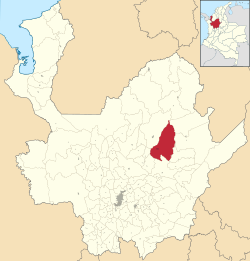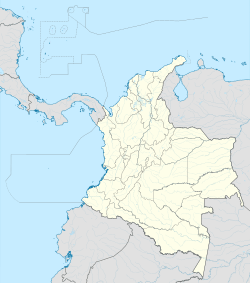Amalfi, Antioquia facts for kids
Quick facts for kids
Amalfi
|
||
|---|---|---|
|
Municipality and town
|
||
 |
||
|
||

Location of the municipality and town of Amalfi in the Antioquia Department of Colombia
|
||
| Country | ||
| Department | ||
| Subregion | Northeastern | |
| Area | ||
| • Total | 1,210 km2 (470 sq mi) | |
| Population
(2015)
|
||
| • Total | 22,088 | |
| • Density | 18.25/km2 (47.28/sq mi) | |
| Time zone | UTC-5 (Colombia Standard Time) | |
Amalfi is a town and a special area (called a municipality) in the Colombian Andes. It is located in the northern part of the Central Mountain Range. You can find it in the Antioquia Department, as part of the Northeastern Antioquia region.
Amalfi shares its borders with several other towns. To the north, it's next to Anorí and Segovia. To the east, it borders Segovia, Remedios, and Vegachí. South of Amalfi are Vegachí, Yalí, Yolombó, and Gómez Plata. Finally, to the west, it's bordered by Anorí and Guadalupe. The town also has its own airport, Amalfi Airport.
Amalfi is quite a large municipality, covering about 91 square miles (1210 square kilometers). In 2015, about 22,088 people lived there. The main town area, often called the county seat, had 11,481 residents. This town is located in the La Víbora Valley, a mountainous region rich in gold and water.
People started moving to Amalfi in the mid-1800s. They came from other parts of Antioquia, like Copacabana and Rionegro. Migrants also arrived from countries such as Spain, Syria, and Germany. These new settlers were often looking for gold. Over time, they mixed with the native people who had lived there for thousands of years.
The municipality is famous for the "Tiger of Amalfi." This refers to a real event in 1949 when locals hunted a Bengal Tiger that had been set free in the area. Since jaguars (which look similar) also live there, the story became very popular. Because of this, the people of Amalfi are known as the Tigers of Amalfi.
Contents
What Does the Name Amalfi Mean?
The name Amalfi in Colombia comes from the Italian city of Amalfi in Salerno. There are two main ideas about how the Italian city got its name:
- Some think it comes from the name Melfi. This is a town in southern Italy, located at the foot of the Vulture Mountain. Today, Melfi is a place for business and tourism.
- Others believe it comes from a Roman gens. This was a powerful Roman family from the 1st century. This Roman family might have founded the Italian town on the Adriatic coast in 596 AD.
Amalfi's Past: A Journey Through Time
Ancient Times: Who Lived Here First?
Amalfi's location was like a natural pathway for ancient people. It sits between the Andes mountains and the flat lands leading to the Caribbean Sea. Native Americans have lived in what is now Colombia for about 15,000 years. In the Amalfi area, archaeologists have found signs of human life from 9,000 years ago.
These ancient groups were called the Yamesíes, Guamocoes, and Tahamíes. Even though these cultures are no longer distinct, their descendants are part of the mixed population today. You can still find parts of their old traditions, names, and beliefs. Things like the Jaguar cult, ancient rock carvings (petroglyphs), and certain words are still studied by experts today.
A Land of New Beginnings
For about 300 years, during the Spanish colonial rule (from the 1500s to the 1700s), the Amalfi area wasn't very interesting to the Spanish. They were more focused on nearby regions like Segovia and Remedios, which had rich gold mines.
In 1580, a Spanish explorer named Gaspar de Rodas traveled through the region. He followed the Porce and Nechi rivers but didn't build any Spanish towns there. He later founded the town of Zaragoza in 1581 while looking for a way to connect with the Magdalena River.
In the 1700s, groups of traders from cities like Cartagena de Indias and Santa Marta settled in the Lower Cauca region of Antioquia. They were also looking for gold. They founded the first town in what is now Amalfi territory, called Cancán. Today, this area is known as Corregimiento de Portachuelo. They built a Catholic church, but the town was later abandoned.
After Antioquia became independent, a general named Julián Trujillo tried to restart the old town under the name San Martín. However, not enough people moved there, and it was abandoned again in 1888.
During a period known as the Antioquean Colonization, many families moved to the Amalfi region. They came from towns like Rionegro and Medellín, seeking gold and new chances. Along with these Antioquean settlers, people from other countries also arrived. These included German Jews, Arabs from the Middle East, and Chinese workers who were helping build the Antioquean railway.
The Official Founding of Amalfi
In 1838, a Spanish Catholic priest named José Santamaría y Zola led a group of families. They were searching for new opportunities near gold mines. They founded a town in the Riachón River Valley, which was completed in 1843. The first settlers gave the town several names, like Riachón and Nueva Población.
Later, a bishop named Juan de la Cruz Gómez Plata visited Italy. He fell in love with the Italian town of Amalfi in Salerno. Even though the Italian town was by the Tyrrhenian Sea and very different from the mountain town in Antioquia, Bishop Gómez Plata thought their "blue skies" looked similar. Because of this, he decided to name the new gold mining settlement Amalfi-Antioquia.
A Swedish migrant, engineer, and geographer named Carlos Segismundo de Greiff (1793-1870) helped design the streets of the new town. He worked with Professor Antonio Aguilar to create a plan that is still admired for its organized layout in the Riachón Valley. This Swedish Greiff was the first ancestor in Colombia of the famous Greiff family. This family includes well-known people like the poet León de Greiff and the politician Gustavo de Greiff Restrepo.
See also
 In Spanish: Amalfi (Antioquia) para niños
In Spanish: Amalfi (Antioquia) para niños



